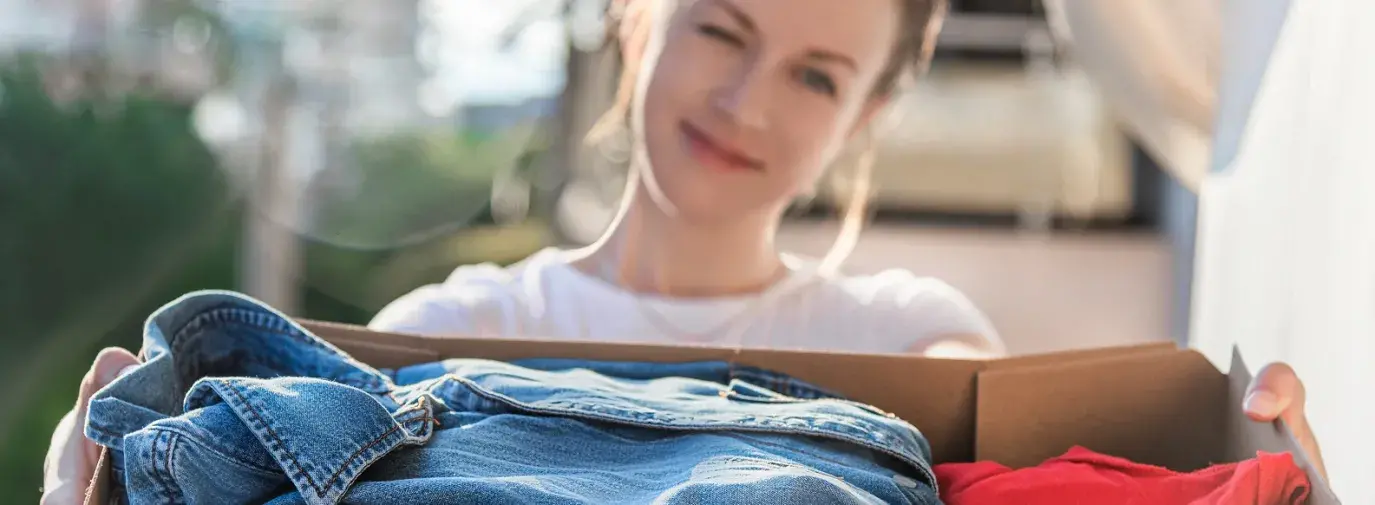
The state of the fashion industry is harrowing, to say the least; can online thrifting help abate this crisis?
The fashion industry is currently responsible for roughly 10% of all humanity’s carbon emissions, making it one of the world’s largest air polluters. It is also the second-largest consumer of the world’s water supply. It takes roughly 650 gallons of water to make one new cotton t-shirt and a single pair of jeans takes 1,800 gallons. Plus, studies show that the constant shopping culture combined with low-quality goods from the fast fashion industry means the average American tosses 81 pounds of clothing annually. When you add all that waste up, roughly 26 billion pounds of textiles are thrown into landfills every year in the United States.
It’s abundantly clear that we need to push for major change in the fashion industry. Secondhand shopping significantly reduces textile waste, lowers our carbon footprints, and helps conserve water. Recirculating clothing through thrifting is a solution that benefits both our world and our wallets.
Over the past decade, companies have taken notice of the trend towards thrifting, and online clothing resellers like Depop, ThredUp, and The RealReal have popped up alongside fast fashion retailers. These online thrifting sites make a lot of promises surrounding the positive environmental impacts that they create.
These companies create a lot of messaging around reducing textile waste and creating a circular economy, making it difficult to discern whether or not these sites are greenwashing their services or changing the market for the better. Ultimately, the decision of whether to use them may boil down to your location, lifestyle, and consumption habits.
Green: E-Thrifting
Transit is a major component of shopping. According to a 2008 study by Carnegie Mellon University, e-commerce is the more energy-efficient option in roughly 80% of transactions, with 30% less energy use on average than in-store purchases. According to the Department of Transportation and the National Highway Traffic Safety Administration, Americans travel a total of 14 miles on an average shopping trip, with 1.5 items purchased per trip. According to the Carnegie Mellon study, delivery trucks drop off approximately 1 package for every 0.1 to 1 mile that they drive. If you live in a rural or suburban area and can’t reach your destination by foot or bike, online thrifting may be the way to go.
ThredUp is a popular site that takes donations and pays people a small percentage of what they will sell them for or may decline to take a donation. The company reports it has processed 125 million items as of 2021 and displaced 1.1 billion pounds of carbon emissions. It does not report what it does with donations it declines or items that do not sell, making it similar to a traditional large thrift store chain, like Goodwill or Savers, plus the added shipping to customers.
Poshmark, eBay, and Depop are platforms where you can buy from individual sellers, who may have different sustainability and business goals. Depop’s 2021-22 sustainability plan outlines many goals, like achieving carbon neutrality by the end of 2021, but not all of its goals are specific and measurable. Poshmark does not have public-facing sustainability goals or reports. Green America encourages all businesses to be transparent in their practices and goals, in part so their customers can help hold them accountable.
Take time to consider where your money is headed. Brick-and-mortar thrift shops may support
charitable causes and create jobs
in your community.
Greener: Thrift Locally
Local thrifting is one of the greenest ways to get your clothes, period. Brick-and-mortar thrift shops create jobs in your community and often are nonprofits or support charitable causes. You can also find green materials at more accessible prices than buying new.
If you want to broaden your selection of sellers while keeping it local, you can check out online community hubs like your town’s Facebook groups, Nextdoor, Freecycle, or local websites that host forums for online sales and trades.
When you thrift thoughtfully, whether online or in-person, you’re keeping clothes out of the landfill and contributing to greener business models than conventional fashion.
Tips for Greener E-Thrifting
To maximize your emissions savings while online shopping, opt for the tortoise instead of the hare. Choosing a longer shipping window, where offered, allows companies to reduce packaging and fuel by bundling your orders in the most efficient way. Further reduce your emissions by narrowing down your search results to only display listings from local sellers or warehouses. Etsy, Poshmark, Depop, ThredUp, and eBay all offer this filter option.
Don't Rely on Returns
Frequently returning packages is another polluting pitfall of all e-commerce; free returns aren’t free from emissions—it doubles the transportation emissions, and oftentimes, returned items aren’t resold. Instead, they’re sold in massive pallets to liquidation companies, or worse, trashed.
In 2019, Etsy became the first major online retailer to fully offset its emissions generated from shipping and packaging. Items returned to ThredUp are subject to a $1.99 restocking fee in order to ensure that they can be inspected and re-listed on the site. On sites like Poshmark, Depop, and eBay, return policies may differ from seller to seller.
Ensure that your pieces are the perfect fit and won’t need to be returned by checking garment measurements prior to adding them to your cart. If you can’t find measurements, message the retailer for more information.
Shop For Quality
Being able to filter by the brand is another perk of e-thrifting. Even though you’re picking up items secondhand, buying clothing from environmentally conscious brands that offer quality materials is still key. Along with encouraging others to buy green, sporting these brands promotes garments made with ethically produced textiles such as organic cotton, hemp, soybean fiber, and linen. Check out GreenPages.org to find over 50 clothing brands that have achieved Green America’s certification.
Though the internet often encourages excessive shopping, it can also act as an invaluable tool to curb unnecessary emissions. If you live in a suburban or rural area, lack local stores with the items you need, and are dedicated to conscious consumption, online thrifting may be right for you.







